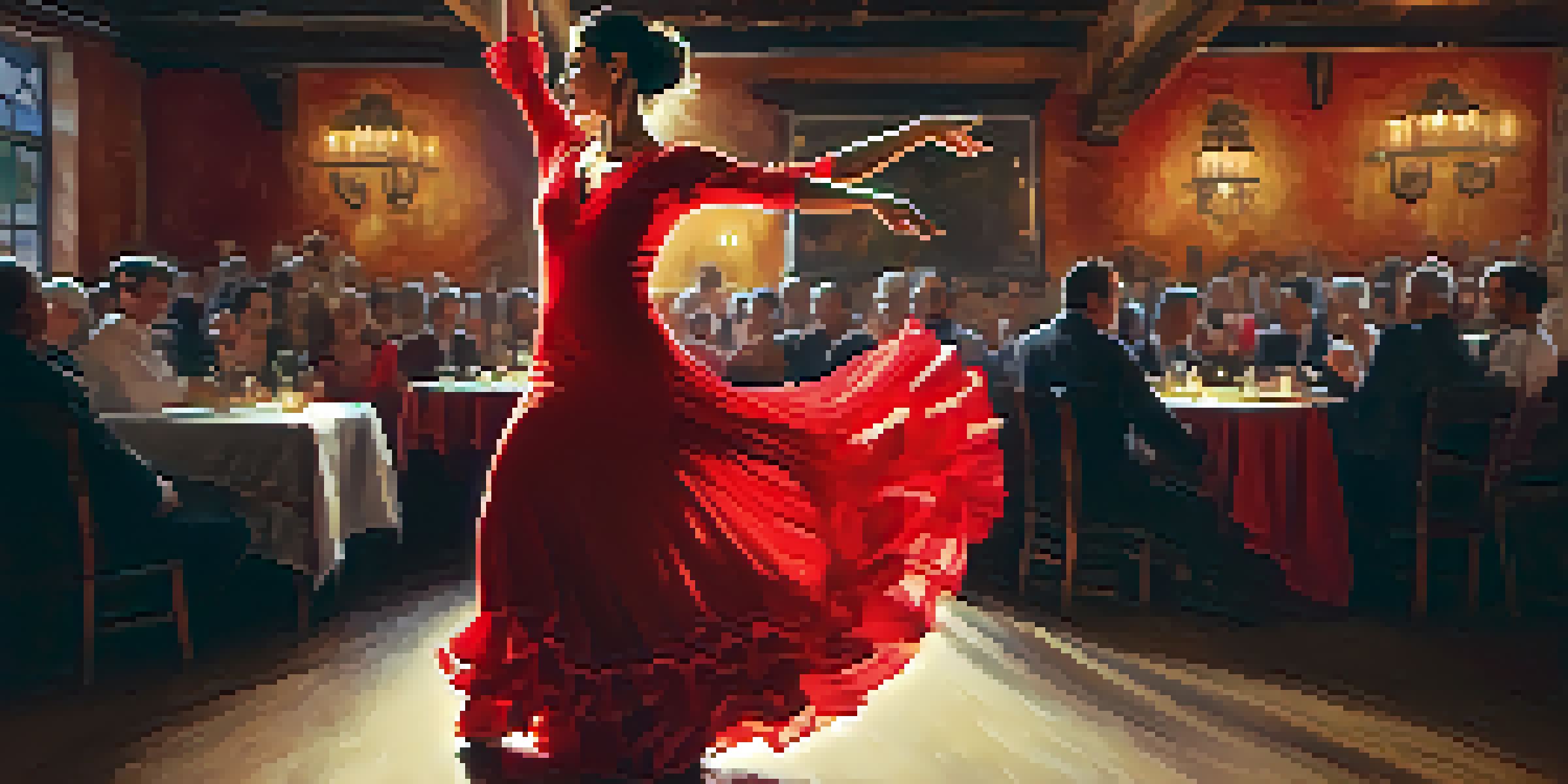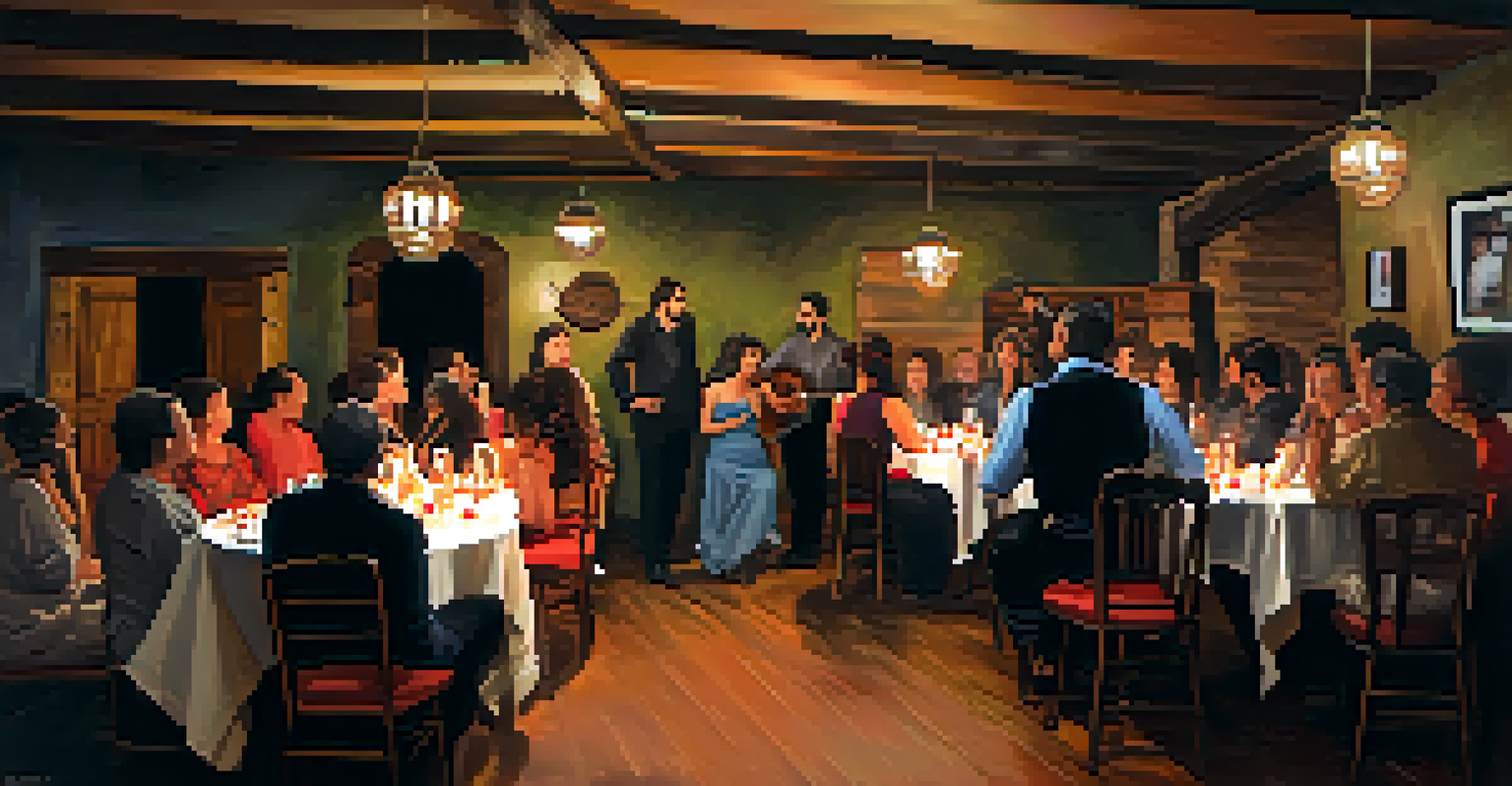Exploring Flamenco: The Heartbeat of Andalusian Culture

The Origins of Flamenco: A Cultural Mosaic
Flamenco is more than just a dance; it's a living narrative of Andalusian history. Originating from the fusion of various cultures, including the Gypsies, Moors, and Jews, Flamenco embodies the struggles and joys of these communities. Each performance tells a story, often reflecting the emotional landscape of its roots. The result is a vibrant art form that resonates deeply with its audience, making it a unique cultural expression.
Flamenco is the soul of Spain, a dance that speaks to the heart and tells the story of the people.
The earliest influences of Flamenco can be traced back to the 18th century, where it emerged in the Andalusian region of Spain. As it evolved, it absorbed elements from various music styles, integrating guitar, singing, and dance seamlessly. This blend created a rich tapestry of sound and movement that is both captivating and poignant. Understanding these origins enriches the experience of watching a Flamenco performance.
Today, Flamenco is celebrated worldwide, yet it remains deeply tied to its Andalusian roots. Festivals, performances, and even informal gatherings bring communities together, preserving this cultural heritage. It's not just about art; it's about identity, belonging, and the shared experience of life in Andalusia.
The Elements of Flamenco: Dance, Music, and Song
At the heart of Flamenco are three core elements: dance (baile), music (toque), and song (cante). Each element plays a vital role in creating the emotional depth associated with Flamenco. The dancer's movements express feelings that words often can't capture, while the guitar and singing enhance this emotional tapestry. Together, they create a powerful experience that resonates with audiences.

The dance itself is characterized by intricate footwork, graceful arm movements, and expressive facial gestures. Every stomp and twirl tells a story, conveying passion, pain, and joy. Dancers often improvise, adding a personal touch that makes each performance unique. This spontaneity is part of what keeps Flamenco alive and relevant across generations.
Flamenco's Rich Cultural Roots
Flamenco is a vibrant art form that reflects the historical and cultural influences of the Gypsies, Moors, and Jews in Andalusia.
Equally important is the music, which typically features a guitar and sometimes includes clapping (palmas) or castanets (castañuelas). The guitar sets the rhythm and mood, with its strings producing a rich, soulful sound. The interplay between the singer and musician creates a dynamic flow that is as unpredictable as it is thrilling. This synergy is what makes Flamenco performances so captivating.
The Emotional Depth of Flamenco: Duende
A key concept in Flamenco is 'duende,' a term that refers to the emotional intensity and passion found in the performance. It's that almost indescribable feeling that can evoke tears or exhilaration in both the performer and the audience. Duende captures the essence of Flamenco, as it reflects the raw emotion that can be expressed through music and dance.
Duende is not a matter of skill; it is a matter of the soul, a profound connection between performer and audience.
The pursuit of duende is often seen as a spiritual journey for artists. It requires a deep connection to the music, the dance, and the audience. Performers dedicate themselves to honing their craft, striving to reach that transcendent level where the art becomes a form of catharsis. This dedication is palpable and adds a layer of authenticity to every performance.
Witnessing duende in action can be a transformative experience for spectators. It's not just about skill; it's about the soul of the performance. When performers tap into this deep well of emotion, they invite the audience to join them on a journey that can leave lasting impressions and foster connections across cultures.
Flamenco Styles: A Rich Diversity
Flamenco is not a monolithic art form; it encompasses a variety of styles, each with its own unique character. These styles, known as 'palos,' range from the joyous 'alegrías' to the more somber 'soleá.' Each palo has its own rhythm, mood, and story, reflecting the vast emotional spectrum inherent in Flamenco music and dance.
For instance, 'bulerías' is a lively and fast-paced style that encourages improvisation, while 'farruca' showcases the strength and precision of the dancer's footwork. These differences not only highlight the versatility of Flamenco but also allow performers to express their individuality. This rich diversity keeps the art form fresh and engaging for both artists and audiences alike.
Emotional Power of Duende
The concept of 'duende' captures the intense emotional experience in Flamenco, inviting audiences to connect deeply with the performance.
Exploring these various styles offers a deeper appreciation for Flamenco as a whole. Each performance can introduce you to a new rhythm or emotion, keeping the tradition alive and evolving. This dynamic nature is what makes Flamenco a continually relevant and exciting form of cultural expression.
Flamenco in Contemporary Culture: A Global Phenomenon
While Flamenco has deep roots in Andalusia, its influence has spread across the globe, captivating audiences far beyond Spain. In recent years, the art form has evolved, blending with various musical genres and styles, creating exciting new interpretations. This fusion keeps Flamenco fresh and introduces it to new generations of fans.
Artists are experimenting with Flamenco by incorporating elements of jazz, hip-hop, and even classical music, resulting in innovative performances that challenge traditional boundaries. These collaborations not only showcase the versatility of Flamenco but also highlight its ability to adapt and thrive in a modern context. This evolution is essential for keeping the art form relevant in an ever-changing world.
The global popularity of Flamenco has also led to an increase in festivals and workshops worldwide, allowing enthusiasts to immerse themselves in this vibrant culture. From New York to Tokyo, the spirit of Flamenco is alive and well, inviting people from all walks of life to experience its beauty and passion.
The Role of Flamenco in Community and Identity
Flamenco serves as a powerful tool for community and identity among Andalusians. It's more than just entertainment; it fosters a sense of belonging and shared cultural heritage. Local gatherings, known as 'peñas,' provide spaces for people to come together, share stories, and celebrate their connection to Flamenco.
These communal experiences often feature performances by both seasoned artists and aspiring newcomers, creating an inclusive environment that nurtures talent and encourages collaboration. This sense of community reinforces the idea that Flamenco is a collective expression, one that thrives on the contributions of many. It’s a beautiful reminder of how art can unite people.
Flamenco's Global Evolution
Flamenco has adapted and blended with various musical genres worldwide, ensuring its relevance and appeal to new generations of fans.
Furthermore, Flamenco plays a significant role in shaping personal and regional identities. Many individuals find pride in their Flamenco heritage, using it as a means to connect with their roots. Through dance, music, and song, they not only preserve their culture but also share it with the world, ensuring that the heartbeat of Andalusia continues to resonate.
Experiencing Flamenco: Tips for the Best Enjoyment
If you're eager to dive into the world of Flamenco, attending a live performance is an experience like no other. Look for authentic shows in Andalusia, where you can witness the passion and skill of seasoned artists. Consider smaller venues or traditional 'tablaos,' where the intimate setting enhances the connection between performers and the audience.
Before the show, familiarize yourself with the different styles and rhythms of Flamenco. This knowledge will enrich your experience, allowing you to appreciate the nuances of each performance. Don’t hesitate to engage with the performers, as many Flamenco artists love to share their stories and insights about their craft.

Lastly, immerse yourself in the culture surrounding Flamenco. Enjoy traditional Andalusian cuisine at local tapas bars, or take a dance class to try your hand at the art form. By embracing the full experience, you'll not only appreciate Flamenco more but also gain a deeper understanding of its significance in Andalusian culture.